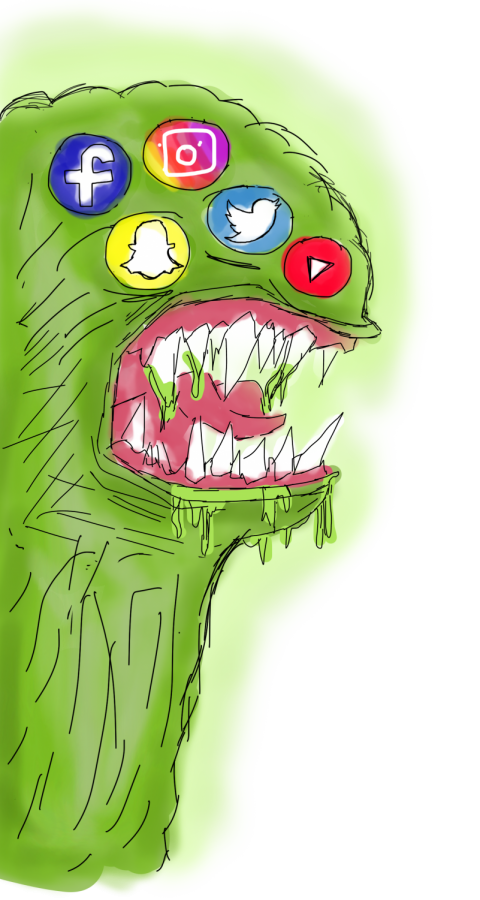The Monster: Uncovering the harmful effects of social media
Students unleash passive-aggressive monsters on social media to deal with their problems

September 26, 2018
It’s midnight and as we scramble to finish homework, we suddenly remember something: we haven’t sent our streaks yet. Panic takes over as we frantically hunt for our phone. Snap, caption, select, send. Thank God most of our streaks lived — that was a close one. Who doesn’t love keeping up their streaks? And here’s the bonus: we can break them whenever we get mad at the other person … and problem solved! There’s no need to confront the issue directly because hiding behind the ghost icon is so much easier. Turning to social media after conflicts is a lot more common than we think. The second a relationship turns awry, the petty, passive-aggressive monster inside us urges us to break that streak, click the unfollow or block button, unlike all their pictures and delete all our previous comments on their posts.
It’s like a throwback to kindergarten. Most of us have experienced an incident involving a dispute about crayons that ended with an angry 5-year-old breaking the desired crayon instead of adopting the concept of sharing. But we’ve grown past that sort of childish behavior — or so we think.
Most of us are aware that an overuse of social media detracts from authentic, in-person interactions and prevents us from developing more meaningful relationships. In fact, the Pew Research Center has reported that 54 percent of teens text their friends at least once a day, while only 33 percent of them interact with them face-to-face.[/pullquote]Most of us are aware that an overuse of social media detracts from authentic, in-person interactions and prevents us from developing more meaningful relationships. In fact, the Pew Research Center has reported that 54 percent of teens text their friends at least once a day, while only 33 percent of them interact with them face-to-face.
As stated by MIT psychologist Sherry Turkle, “We are sacrificing conversation for mere connection.” However, it’s interesting how even though social media can often take away from forming deeper, more personal relationships, the opposite is true when deciding to express our inner, passive-aggressive monsters. Dealing with relationship-related issues is remarkably personal, yet we repeatedly decide make the choice to deal with these issues on platforms that aren’t face-to-face.
In an age where everything is at our fingertips, the urge to “solve” our confrontation-based issues behind a screen can be hard to resist. According to psychologist Liraz Margalit, “a computer does not require cognitive or emotional involvement, making our interaction with it much easier.”
If given the choice between hiding behind our social media handles and having that face-to-face conversation, many of us would choose the former.
Granted, it’s perfectly okay to remove someone from our social media because we’ve lost touch or just don’t know them. We all have those 50 followers that seem only vaguely familiar. A Yale University study found that we don’t recognize about 28 percent of our Facebook friends. However, a problem arises when we start blocking and deleting people out of spite as a way to indirectly signal our feelings.
We break Snapchat streaks and block people — out of sight, out of mind. But, in reality, these actions do nothing to resolve the issue. It’s easy to hit ‘block,’ but it’s not as easy to forget about the person and the problem. In fact, according to cyberpsychologist Grainne Kirwan, blocking people on social media can be “a hasty, emotion-based response to a stressful event, which may turn a difficult relationship phase into a non-salvageable one.” Relationships can get complicated; no two people see eye-to-eye on every single issue. However, at the end of the day, relationships should be built on a foundation of compromise and communication. Hurt feelings and opposing viewpoints can often be mended through simple discussion, but petty forms of revenge can do the exact opposite — wreck it beyond repair. By opting for the easy way out, we simply limit discussion and may make the problem worse.
Feeling ‘vengeful’ is human nature, but this monster further encourages the desire for revenge — ironically, it’s a social creature. It clones itself. When dealing with the aggression of a monster, people tend to reciprocate with their own monster.
For example, when streaks are broken, the person on the receiving end would probably block you and consider the matter over with. This reciprocation of immature behavior creates a chain of events that leaves you with exponentially more drama than you began with. It’s hard to think ahead when we first unleash it, but very soon, an abundance of monsters thrives among our social platforms. In a survey of 374 students, 34% believe they have gotten into petty drama through social media, proving that we’re no strangers to unleashing our monsters on social media.This tendency to seek revenge is especially prominent when it comes to private accounts on Instagram, or “finstas.” Instagram is 56 percent of MVHS students’ favorite social media (according to a survey of 363), and 54 percent of MVHS students (out of a survey of 374) have a private Instagram account. Originally, they were created as a way for close friends to share insides jokes and the occasional embarrassing picture, yet now, these accounts have added to a culture in which people rat each other out, snitch, post passive-aggressive content and are even used as a way to alienate others by promoting a culture of exclusivity. Snapchat has copied this trend by recently adding a feature called Private Stories. They too are hopping on this bandwagon, and it seems like a lot of our monsters are on board.
Social media can be beneficial in numerous ways, and can serve as a valuable tool to strengthen connections between people. However, if we use social media with ill intent, the negative aspects overshadow the positive. Once again, irony comes into play here. Social media’s main goal, when excluding the monsters running rampant, is to help us build connections. We share pictures, tweets and texts to keep each other updated on our lives. It’s unfortunate that this monster takes that away from us by doing the exact opposite and hurting these relationships.
We seem to have little hesitation when it comes to unleashing our passive-aggressive monsters, but too much hesitation when it comes to real-life confrontations. Social media isn’t real life, and we take advantage of this because our monsters thrive so much better behind a screen. Yet problems aren’t going to be solved unless people are bold enough to dissipate the petty ghost within them and reach out in person. We know, drama can escalate quickly and these monsters are always looking for the slightest opportunity to escape — but turning to social media serves only to tangle up the web of complexity rather than unravel it.




























